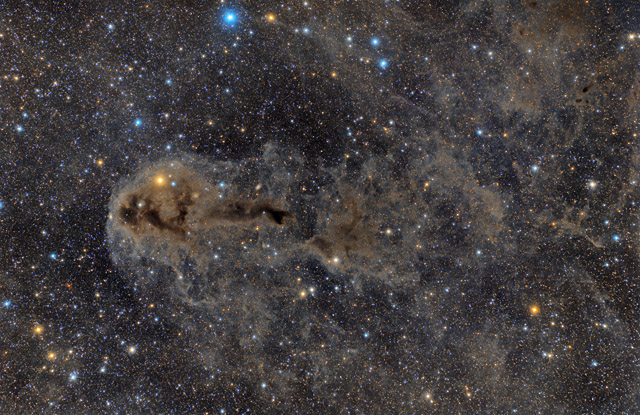LDN 1251 - A Dark Nebula in Cepheus
|

|
LDN 1251 is a low mass molecular cloud in the constellation of Cepheus. In addition to the dark nebula, this image also shows a handful of PGC galaxies that shine far in the background behind LDN 1251. These can be identified in the annotated version of this image.
This image shows a section of sky roughly 3.25 x 2.1 degrees. In this image, North is Up.
| Exposure Details |
| Lens |
Nikon 600mm f/4 ED IF |
| Focal Length |
600mm |
| Focal Ratio |
f/6 |
| |
| Mount |
Schaefer GEM - 7 1/2 inch Byers gear |
| Guiding |
William Optics 50mm guide scope, Lodestar autoguider, PHD Guiding |
| |
| Camera |
Hutech modified Canon 6D |
| Exposure |
146 subs of 300 sec @ ISO 1600 (12+ hours total exposure) |
| Calibration |
30 darks, 30 flats, 30 flat darks, 30 bias |
| |
| Date |
August 10, 11, and 14, 2015 |
| Temperature |
55F on 8/10 and 8/11, 65F on 8/14 |
| SQM Reading |
21.45 (Bortle 4) on 8/10, 21.35 (Bortle 4) on 8/11 and 21.40 (Bortle 4) on 8/14 |
| Seeing |
5/5 on 8/10 and 8/14, 4/5 on 8/11 |
| Location |
Pine Mountain Club, California |
| |
| Software Used |
Images Plus 5.75 for camera control, calibration, and stacking. Images Plus 6.0.5 for DDP stretching, star size reduction, smoothing and noise reduction, frequency filter, color channel splitting and recombination. Photoshop CS5 used for levels and curves, screen mask invert, high pass filter, lab color, saturation adjustments, selective color, and match color. Gradient Xterminator for gradient removal. Carboni Tools for additional noise reduction and smoothing. HLVG for additional color correction. Registar 64 for subexposure alignment and color channel alignment. Pixinsight 1.8 for dynamic background extraction, color calibration, histogram transformation, multiscale median transformation, morphological transformation, and exponential transformation. |
| Notes |
LDN 1251 is one of those objects that is not commonly photographed. The nebula is quite faint, but it ends up creating a beautiful field of view. I tried a number of new processing techniques with this image, including a masked stretch of the nebula and an exponential transformation. I'm very happy with how these processes worked, as I was able to bring out a dramatic amount of nebulosity while keeping the stars reasonably well controlled.
This image was published by Astronomy Magazine as its Picture of the Day for September 1, 2016! |
|
|